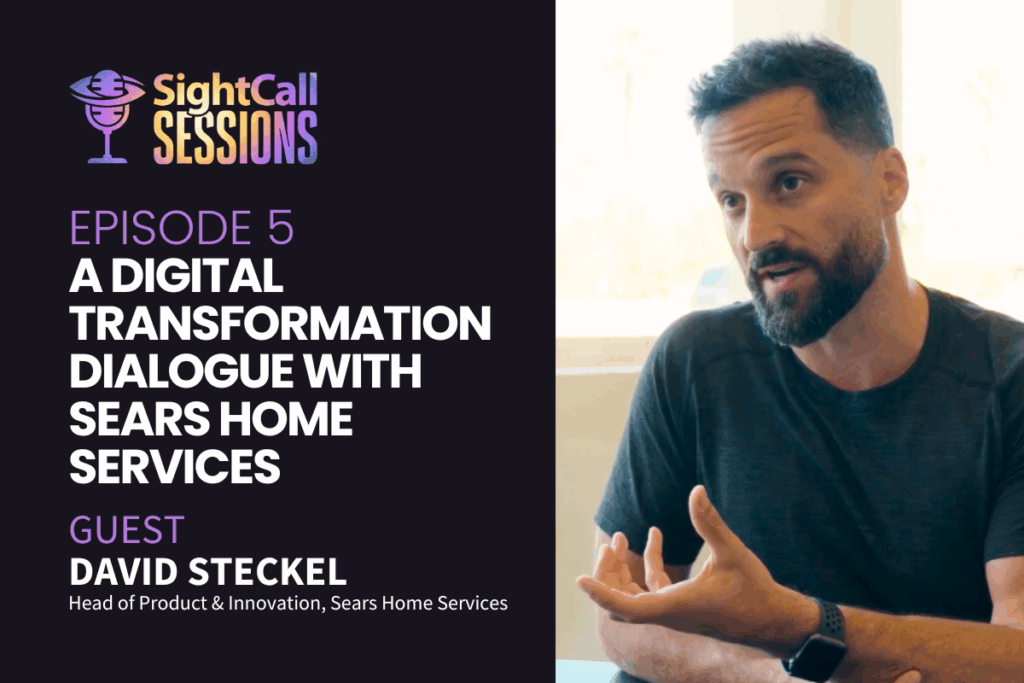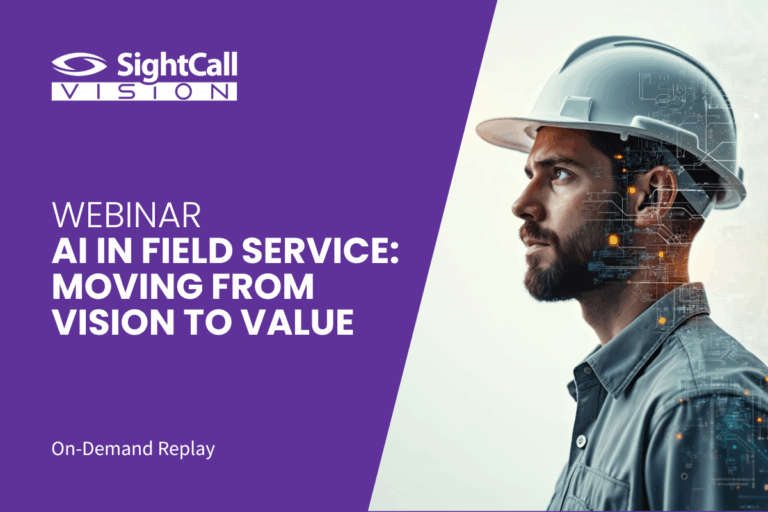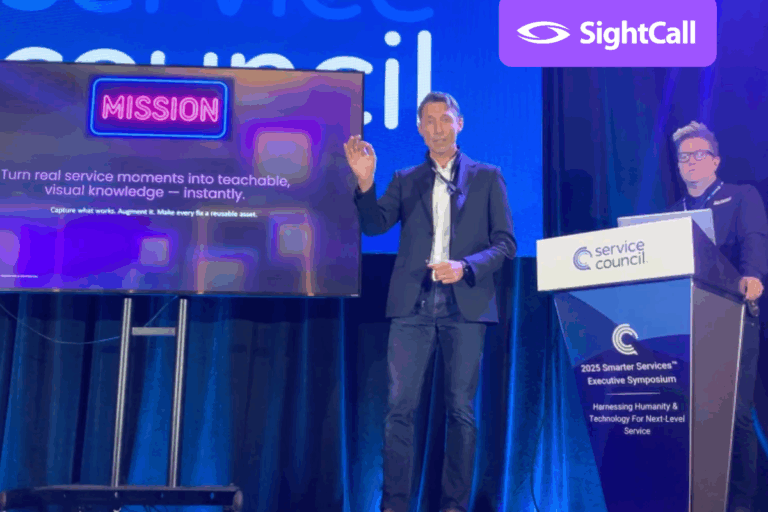SightCall Sessions: Episode 5
Digital transformation and innovation isn’t easy. And doing it for a 132-year-old company brings its own unique set of challenges. But you’ll hear right from the start that David Steckel is up to the task.
As Head of Product and Innovation for Sears Home Services, he’s fully embracing the service technology revolution and tackling innovation head on.
During a break in the action at Field Service Palm Springs, David sat down with SightCall’s VP of Product Marketing, David Swift, for a quick chat about automation, AI and building better customer journeys from scratch.
Opening and Conference Insights
David Swift:
I’m here with David Steckel, Head of Product Innovation at Sears. We’re happy to be at Field Service USA — there’s been a lot of insightful discussion. Welcome to the SightCall Sessions podcast.
David Steckel:
Thank you for having me. It’s been great. I’ve learned a lot at this conference — it’s nice to be among peers who are all going through their own digital transformations.
Digital Transformation at Sears
David Swift:
We had a great panel discussion earlier, and I want to reference that for our listeners because you shared some really interesting insights around AI — specifically generative AI — and how you’re approaching transformation at Sears. Can you talk about that?
David Steckel:
The exciting opportunity for Sears right now is the timing of our digital transformation. We’re refactoring the entire tech stack and customer experience at the same time as this shift toward AI is happening. That allows us to rethink the entire customer journey — from submitting a request through execution — and decide if we’ll build it the same way or find a better approach.
While doing this, we’re still operating one of the largest appliance repair companies in the U.S., so we’re constantly gathering data that helps guide our decisions. For example, the homeowner only cares about the fastest path to resolving their problem — “My fridge isn’t working, get this done quickly.”
Twenty years ago, customers had fewer options; now, they have dozens. That means our transformation has to leap ahead, not just meet expectations.
That’s where working with SightCall comes in — leveraging technologies that help us accelerate resolution. If speed matters to customers, cycle time becomes our key operating metric. By using SightCall to diagnose issues remotely, we can reduce truck rolls, which improves cycle time and the customer experience. That drives NPS up, referrals increase, and partners prefer us — it’s a positive flywheel.
Recurring Revenue and Customer Lifetime Value
David Swift:
That’s exciting. As an innovator, what themes or ideas have you picked up from others at the conference?
David Steckel:
I wouldn’t say new ideas as much as seeing similarities. Five years ago, every company was trying to become a FinTech. Now, the conversation is about converting transactional revenue to recurring revenue — focusing on lifetime value (LTV) instead of single transactions.
Everyone’s looking for ways to build moats around their customers so they can’t churn. It’s a big shift across industries.
David Swift:
That focus on LTV makes sense, especially as acquisition costs rise.
David Steckel:
Exactly. Customer acquisition costs are going up because everyone’s competing on the same platforms like Google. Performance marketing is crowded. Since we can’t easily increase order size, we have to increase lifetime value through repeat business and loyalty.
Building Intelligent Automation Layers
David Swift:
Let’s talk more about generative AI. Everyone’s discussing it, but I like how you’re approaching it with precision — using automation where it truly fits.
David Steckel:
There’s a great book called The Automation Mindset that explains how to create an automation layer within your business.
We looked at every stage of the customer journey, the technician journey, and internal processes, asking: what can we automate quickly?
We’re building what you could call “GPTs” for each stage — from when a customer makes a request, to scheduling, to confirming appointments. We’ve created SLAs for each touchpoint so we’re no longer reactive.
For example, if a customer doesn’t respond to a “technician is on the way” message, our system can automatically trigger an outbound call instead of relying on the technician.
All these automations are connected by an orchestration bot that communicates across systems. So, if a customer texts “Hey Sears, where’s my tech?” the bot pulls the relevant information and replies instantly. It’s all about reducing friction through intelligent orchestration.
Generative AI isn’t ready to read your P&L and create OKRs — we have to make our data explicit and structured first.
David Steckel
Clarifying the Role of AI
David Swift:
That’s a great example of applying AI intentionally — not spreading it thin across everything.
David Steckel:
Exactly. You can’t just say, “AI, fix this.” You have to identify the root problem. Otherwise, you only treat symptoms.
For example, a large percentage of our orders still require manual intervention — like when a part is backordered. We’ve started process mapping each of those workflows to see where we can automate steps.
In a large business, that means rigorously documenting 50, 100, even 200 processes. Automation starts with understanding those details, not skipping straight to AI.
Generative AI isn’t ready to read your P&L and create OKRs — we have to make our data explicit and structured first.
Industry Collaboration and Takeaways
David Swift:
It’s clear everyone here at Field Service USA is wrestling with those same challenges — how to structure data and identify what matters most. Thank you for sharing your approach; it’s real knowledge transfer.
To wrap up, what was your favorite interaction here at the conference?
David Steckel:
Aside from hanging out with the SightCall crew, I’d say hearing from Schneider Electric. Sears is 135 years old, Schneider’s over 100. Seeing how these legacy companies are evolving into tech-driven organizations is inspiring.
It shows that with continuous investment in R&D, companies can endure for over a century.
David Swift:
We are definitely surrounded by ancient wisdom here! Thank you so much, David. We’re looking forward to what’s ahead with the SightCall–Sears partnership. It’s going to be epic.
David Steckel:
Absolutely. We’re just scratching the surface of what we can do together.



